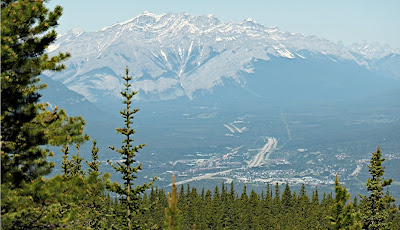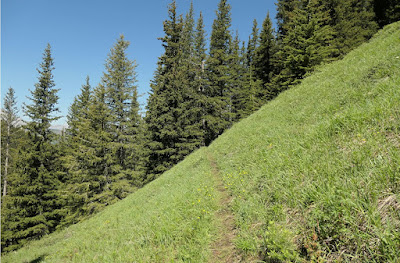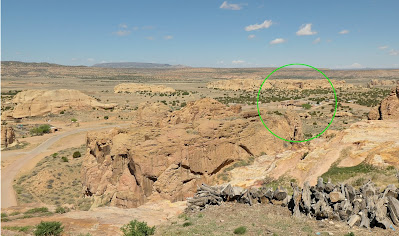On July 5th, 2024, Joan and I began our trip to the Canadian Rockies with an early United flight (6:45am). Our connection to Calgary out of Houston United was delayed because, after we'd boarded, the crew discovered that this international flight was the plane's first flight of the day, and a security sweep was required, forcing us all to de-board, wait, and reboard. Still, this was much better than the previous year, when United canceled our booked flight after everyone boarded and got us there a day late.
A group of twenty or so from Houston were flying to Calgary to observe and study that city's famous "Calgary Stampede," a multi-day collection of events including rodeos, concerts, etc. They were having a jolly time, although one woman had the flight crew scurrying to find her fancy cowgirl hat -- in the back of a bin above her seat. The front of the plane was entertained, that's for sure.
We had to put our foot down at the Enterprise car rental, for they kept offering us an SUV, and we kept insisting that we wanted a car with a trunk. Why? Several times we would be taking a day hike while traveling from one lodge to the next. We did not want our luggage to be visible to anyone in the parking area looking for a profitable vehicle to break into. Finally they found a Nissan Versa, although the car hadn't been washed yet. We took it. Heading west on the Trans-Canada, we stopped at the Kananaskis Visitor's Center to purchase bear spray and a two-day "Conservation Pass," required to park in Kananaskis and the Bow Valley, before reaching our hotel in Canmore. It had been a very long day and we collapsed into bed after dinner.
The next morning, July 6th -- a Saturday -- Joan and I drove a short distance east to the parking area for the Heart Creek Trail, arriving at 9:45, which is not bad for a first day. (Click on any image to enlarge.)The trail meandered to the northeast for a short while. Taking advantage of a sunny Saturday, families, family groups, and their dogs were out in force. On this stretch flowers were also plentiful, including these longtube twinflowers.The trail bent 90° and began to wander up the gorge that Heart Creek has cut between Heart Mountain and Mount McGillivray. The 2013 floods scoured this narrow valley.The trail has been reconstructed but wanders from side to side as the new topography allows. The sheer faces have always been popular for wall climbing.We continued upstream. I took this photo twenty minutes before reaching the end of the trail.We reached the choke point of the 2013 flood.The rock wall and its narrow channel.Joan inspects. As I mentioned, family groups were out in force today; this destination, with its pools of water and rocks for sitting, was where they clustered.On our way back I took this photo of a young lady practicing her "free climbing" -- a friend stands by belaying a rope for protection, but the climber (halfway up) ascends using only natural rock holds.Joan and I finished the return to the parking area. We continued to the west, towards the Heart Creek Vault, a tunnel carved into Mt. McGillivray's limestone, intended (at first) to store essential documents against nuclear attack. Along this stretch we encountered wood lilies,yellow salsify,and a foraging least chipmunk.Closer to the vault, this web of roots caught my eye.The bright day was growing hot. Finally, we reached the entrance to the vault.It's pitch black inside. Joan's headlamp was bright, but mine, an older model (and perhaps with a weaker battery?), was barely adequate for me to shuffle forward carefully. I neglected to take any photos (my camera does have a flash!), but there are images in this blog post from 2018. We snacked in a shady grove nearby, wandered happily a bit further west on the Trans-Canada trail, and then began our return to the car. On the way we admired this spotted saxifrage.Our day had been quite full. The next day would be more challenging: seeing just how far we could manage on a route that had frustrated us in 2022, climbing the Centennial Ridge trail from the north.






















































